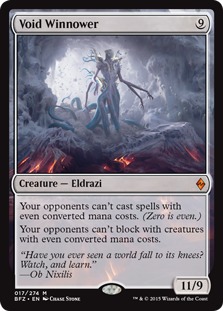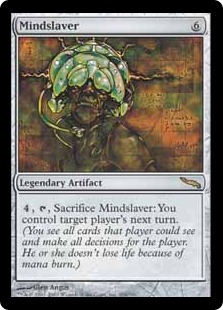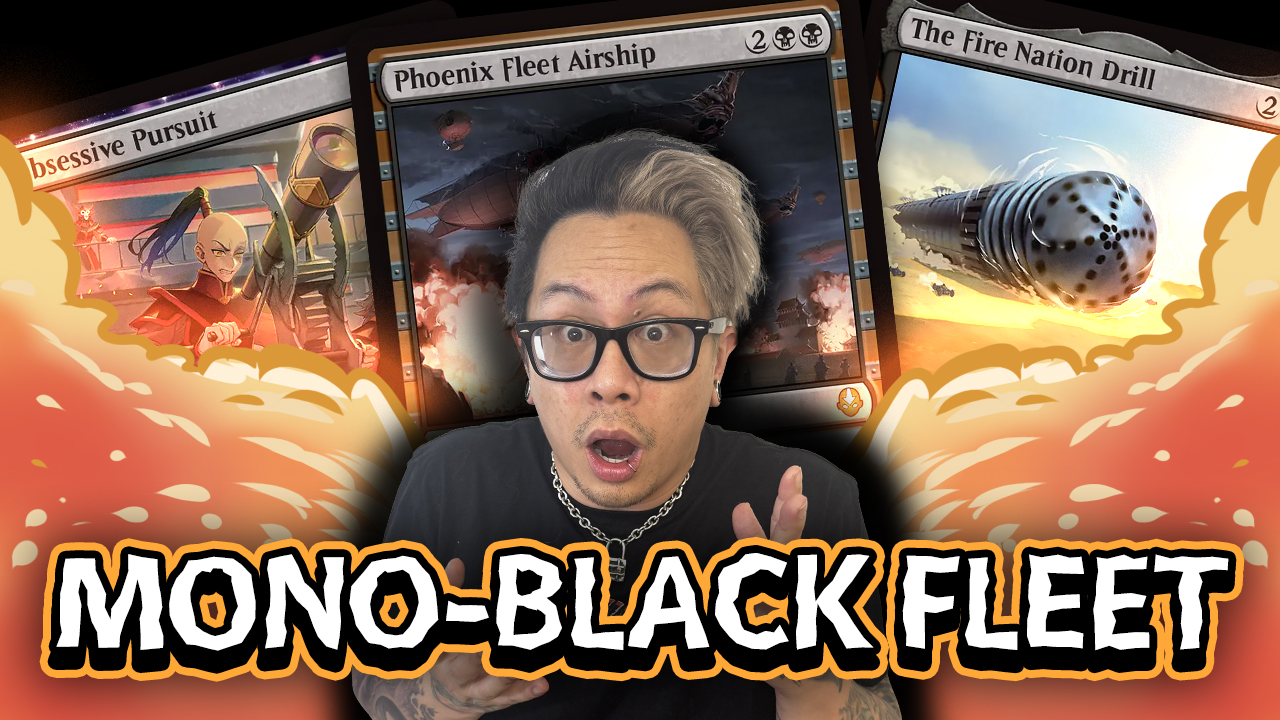Vintage 101: State of the Format
The State of the Format: It's Mishra's World, We Just Live in it.
Before the restriction of Chalice of the Void, Mishra's Workshop decks were firmly tier one. In the time since Chalice took a seat next to Trinipshere on the restricted list, Workshop decks have gone from small portion of the Vintage metagame to back on top. It's my opinion that the various breeds of Workshop decks are among the best in the format. The data on Vintage from MTGGoldfish and other websites shows a lot of Workshop decks at the top tables of tournaments.


From paper results taken from TCDecks.Net, Gush Mentor, MUD (various Workshop decks), Fish, and "Tezzerator" are the top finishing decks. Mentor and MUD have seven Top Eight appearances. Fish and Tezzerator have three Top Eights each. In this grouping, the category of "Fish" covers everything from Merfolk to BUG Fish, and Tezzerator decks generally are Grixis Time Vault decks that are more all-in on the combo plan than the Grixis Thieves decks of last season.
The Magic Online Vintage data can be tricky to make use of because multiple Daily Events every week can cause the numbers to shift very fast. Also most events are only four rounds with the exception of the monthly Power Nine Challenge. In my opinion the key to looking at the online data is to pay attention to lasting trends. If we look at what has been on top of the online meta, it is clearly Ravager Shops, a Workshop Aggro deck. Broadly speaking, Workshop decks are firmly in the top spot, and it has been that way for some time now. It's worth noting there are other categories of Workshop decks throughout the listings, so the true number of decks containing Mishra's Workshop and Lodestone Golem are actually even higher than 19% of the field. The actual percentage is closer to 25%.
Coming in second on the Magic Online meta is Mentor, which can mean a variety of decks. One thing Mentor decks do have in common is Gush, so labeling them as Gush Mentor seems appropriate.
The next two most popular decks are BUg Control and Jeskai Delver. The Delver shells are similar to what has been played since the Delve spells entered the format. The BUg Control decks are fairly similar to the old Grixis Thieves decks but omit Red and include a light Green splash for Abrupt Decay and Sylvan Library. As of this writing, these two categories are sitting at four appearances. That means that all of these decks are putting up only half the numbers of the two top decks, MUD and Gush Mentor.
I think that the most important takeaway is that Workshops are back to dominating the format. I don't like to proclaim any one deck or archetype to be the absolute best, but it's quite clear that losing three copies of Chalice didn't kill the Workshop Pillar. The other big player, Gush Mentor, is also a tier one deck and has been a dominant force as well. They're both decks to beat, and if your pet deck performs poorly against Gush Mentor strategies and MUD, it's probably not a great time for that deck to shine. Even if you're confident in your ability to handle Gush and Shops that isn't enough. You still have to worry about other decks that can easily take a match, like Dredge, Oath, Tezzeret, and many others.
Where does the Dark Petition Storm deck fit in to all of this? Considering that people have spoken about how powerful Storm is as a strategy and debated on whether or not Dark Petition should be restricted you would think that Storm decks would be performing much better than they have. The reality is that the majority of TPS decks listed on MTGGoldfish have placed 3-1 at best in Daily Events, and the number of appearances isn't that high. There has been a perception by some that the top two decks in the format are Workshops and Storm. While I agree that Workshops has earned that spot, Storm has not.
Dark Petition Storm has been the recipient of much hype due to a few good finishes and its adoption by prominent Vintage players in the VSL. This overexposure of the "DPS" decks has led to an increase in the number of people playing it, but it hasn't increased the number of Storm decks that are winning events. I certainly don't think Storm is bad, as a matter of fact it's a very good deck. I just don't think that it's so powerful that it needs to have something restricted.
How Many Viable Archetypes Are There in Vintage?
The current Vintage metagame is far from a "two-deck format." I don't think that it's a three deck format, or even a four deck format. Currently there are many viable options and most of the major archetypes are very much beatable with proper deck construction and sideboarding choices. There definitely is some conflict between different archetypes, and sometimes there is a "rock, paper, scissors" dynamic in which one deck preys on another, but tends to lose to another archetype. Shops beats Storm, Storm beats Oath, and Oath beats Shops, for example. Of course things aren't that simple. Each of these decks can lose to its good match up and beat its poor match up, but it stands as a general concept. Every deck has the potential to spike in the right circumstance.
There are reasons that some decks typically fail against certain pillars more than others. For instance one problem that people face when trying to build a successful "Blue" deck is that many aspects of what makes one Blue deck good versus another Blue deck tend to be useless against the other pillars, like Workshops. Cards like Mental Misstep, Flusterstorm, and Misdirection are almost always dead against Workshops. Many of these Blue staples are bad against Dredge as well because Dredge fights on a different axis. Try casting a Duress against Dredge and you'll be disappointed. The same goes for the hatebears decks and other types of Null Rod aggro decks. Cards that help you beat Force of Will aren't likely to be effective against an army of weenie creatures.
The arms race of Blue mages fighting against other Blue mages has given rise to increasingly greedier decks. Playing a greedier mana base with less lands can allow a deck to draw more spells in a match against another deck, but playing less lands also opens you up to losing to the mana-denial aspect of a Workshop deck. Playing less Dredge hate in your sideboard means you have more room for cards to fight the pseudo mirror, but makes Dredge an unwinnable match up. This doesn't mean that you can't have a deck that's good against a wide variety of Vintage decks as well as the mirror. What it does mean is that if you want to keep playing the same decks and win against a broader portion of the field, you may have to make a few concessions to get to a well-rounded list.
There are many more decks that can compete in Vintage than just MUD and Mentor. It's also possible to play a deck that can beat decks from opposite pillars. Being able to beat Workshops doesn't mean that your deck can't beat Storm, or any of the other Vintage archetypes. No deck is going to beat everything all the time, but Vintage is far from a two-deck format. How many viable decks are there in Vintage? That is a question I cannot answer, because all of the talented brewers in the format are always surprising me with something new.
This article is going to feature a few decks that aren't Workshops, Mentor, or even Storm. All of these decks are viable choices to cash a Daily Event, and I've chosen some of them for their efficacy against Workshops and Storm (and the rest of the field).
Sideboard Cards in the Main Deck: Mono-White Hatebears
If you're looking for a deck that can be competitive against many of the decks in the field, finding a lesser-played strategy can yield positive results. Decks lumped into the Null Rod aggro pillar can have serious game against Workshops and Storm. One such deck is Hatebears. Here's a Mono-White Hatebears list that is particularly effective.

If anyone tells you you can't build a deck that can beat both Workshops and Storm, kindly summon an army of Hatebears and start turning them sideways. This deck is nasty against many of the top decks in Vintage. There's a Grizzly Bears for every single occasion! Playing Oath or Dredge? Boom! I got a main-deck Containment Priest to make your life miserable. You like Storm? Try going off when Thalia and Vryn Wingmare come visit you.
Against Workshops you have a flood of creatures, mana acceleration, and a robust mana base. You also have your own mana denial package. Workshop decks make their living turning symmetrical effects like Thorn of Amethyst into asymmetrical ones. "Spheres" and other lock pieces from MUD decks hurt opponents but don't hurt them thanks to the massive mana-generating power of Mishra's Workshop. This deck can Wasteland those pesky Workshops and leave a Shops player buried under the weight of their own lock pieces! That Trinisphere isn't so fun for a Shops player when they can't generate three mana from one land.
The mana-denial cards work wonders on the various styles of Blue decks in the format. Cavern of Souls is amazing in a deck like this; it makes Force of Will virtually useless. Speaking of Force of Will, other than Force and Mana Drain, Blue decks don't play unconditional counters. Popular counterspells like Flusterstorm and Spell Pierce don't counter creatures.
If you're interested in approaching the Magic Online Vintage meta from a different angle, give this deck a try. This build is much cheaper than some of the other options in the format, and I can tell you from experience that it's just about the last deck a Storm or Oath player wants to see when they're in a tournament.
Odd Oath
The Atog Lord is one of the Vintage players that's always able to surprise me with some new innovation. Upon hearing that it wasn't possible to construct a deck that is good against two polar opposite decks like Storm and Workshops, he challenged himself to do just that. This is the brew he came up with.

I'm a fan of Oath of Druids and that is largely due to Oath's positive matchup against Workshops. On the other hand, the Storm match up is tricky because Oath is on average a little slower. Passing a turn to wait for an Oath activation can be a death sentence when you're facing a deck like TPS. Even if you do activate your Oath, Griselbrand doesn't actually stop Storm from casting a lethal Tendrils of Agony. The interesting fix for the Storm matchup was to include Void Winnower.

I can't even...
Void Winnower stops Storm decks from casting Tendrils of Agony. Most of the lists currently being played on Magic Online have exactly one main deck out to Void Winnower and that is a single Chain of Vapor. The Odd-looking beast from Battle for Zendikar also conveniently stops the Storm player from casting Demonic Tutor to search up Chain of Vapor. Empty the Warrens is also an even-costed card, so that's off the table as well.
The other cool thing about Void Winnower is that it can't be blocked by tokens. All of those pesky Spirit tokens created by Forbidden Orchard can't chump block the Winnower, and the same goes for all of the tokens in Mentor, Pyromancer, or Dredge decks.
I was inspired by this list, so I did some testing with Void Winnower and I was impressed by it. I kept seeing situations where its ability was useful that I hadn't thought of before. There aren't many creatures in Vintage that can block it, and the ones that can aren't usually creatures people want to chump block with anyway. The odd Eldrazi is also good against Workshop decks because they have a large number of creatures and artifacts with an even casting cost.
Other than Void Winnower, The Atog Lord chose to run two different Oath targets. Griselbrand was chosen because it's good in nearly every match up. The third Oath target has changed over the course of a few events, with Inferno Titan being used in the list shown above. Inferno Titan can be hard-cast rather easily in this list as the deck plays a healthy amount of lands and artifact mana. The Titan's ability can kill many of the problematic creatures in the format, and presents a nine-damage clock on an empty board.
Beyond the Oath targets, the deck employs cards to improve it's matches against the top decks in the format. The deck was designed with the idea that it can be a contender whether it's facing Storm, MUD, or anything in between. For instance, Thoughtseize is great at allowing an Oath of Druids to resolve against a control deck, but it's also a great tool to fight Storm. There's Pernicious Deed to act as a catch-all sweeper, dealing with tokens, Hatebears, and many other types of cards. There's even an Ancient Grudge to take out problematoc artifacts, from Lodestone Golem to Time Vault.
Odd Oath is still a brew, but even in its current state it illustrates that there is always something new you can do if you're creative, driven, and a diligent student of the format.
The Hardest-Working Goblin in Vintage

I've chosen to feature this deck because I've never featured a deck like it in an article for MTGGoldfish. It's a personal favorite of mine. For my readers that haven't been exposed to that many different decks, this deck is called Control Slaver. This deck is built to abuse Goblin Welder and the first versions of this deck predate the use of Time Vault as a win-condition. Time Vault didn't have its current functionality until 2008, but that didn't stop the original Control Slaver decks from killing you with a brutal combo.

Control Slaver gets its name from this beastly artifact, Mindslaver. Mindslaver is deadly in a format with as many broken cards as Vintage. It's possible to use multiple Goblin Welders to repeatedly recycle and reuse Mindslaver, but often times one activation will kill someone. You can make a Storm deck kill itself with Necropotence or Yawgmoth's Bargain, you could cause the opponent to Mind Twist themselves by wasting all of their cards, and many other awful things. I once activated a Mindslaver against an opponent playing Oath, and had them trigger Oath to reveal Griselbrand. I killed them by spending their last seven life points to draw seven cards. Trust me, something terrible will happen if you fall prey to a 'Slaver.
The rest of the deck is pretty close to a stock Grixis Control deck. There's the control package of Mana Drains and Force of Wills and the card-drawing power of Thirst for Knowledge. Even though this deck is fairly close to a normal Grixis deck, it has some added advantages against Workshops.

Goblin Welder can be a big help when facing a Workshop deck for a variety of reasons. You can use Welder to generate extra mana with Black Lotus, and with Myr Battlesphere you can create a formidable board presence without using much mana. Goblin Welder can also target your opponent's artifacts, so you can switch out the Lodestone Golem that's attacking you for a different artifact in your opponent's graveyard, negating the attack.
Of course, like most Grixis decks, Control Slaver plays Dack Fayden. Dack is fantastic with Welder, and he's great at stealing Lodestone Golems and Wurmcoil Engines. Dack isn't as well-positioned in Vintage now as he was several months ago due to a large amount of Arcbound Ravagers in Workshop decks, but he is still a very good card in the Workshop match up.
Against dedicated combo decks like Storm or Belcher this deck should be slightly more effective than a normal Grixis Control deck thanks to the addition of Mindslaver. Slaver is going to be slower than most fast combo decks, but if you do fire one off I think it's more likely to end the game on the spot. All-in combo decks have more ways to lose to a Mindslaver than a fair deck does.
Control Slaver isn't likely to be the best deck in the format, but it has a few things going for it. The deck has a powerful game plan that can beat people out of nowhere instead of using its control cards just to "not lose". There's a healthy amount of mana in the deck and some basic lands in the sideboard so beating a deck with a mana-denial plan is within reason. Red also gives the deck access to anti-Blue cards like Pyroblast. Then there's the fact that it's not widely-played currently, so you can catch people off guard.
Conclusion
I certainly hope that I've convinced everyone reading that Vintage is more than a two-deck format. There are a wide variety of decks that can be viable, and we should give the talented deck-building community credit for innovating. The card pool is huge. There are many more decks out there than just Shops and Storm. I'm confident that people will continue to prove my point as time goes on.
Thanks for reading, I'll see you next week. You can follow me on Twitter @josephfiorinijr - Islandswamp on MTGO













